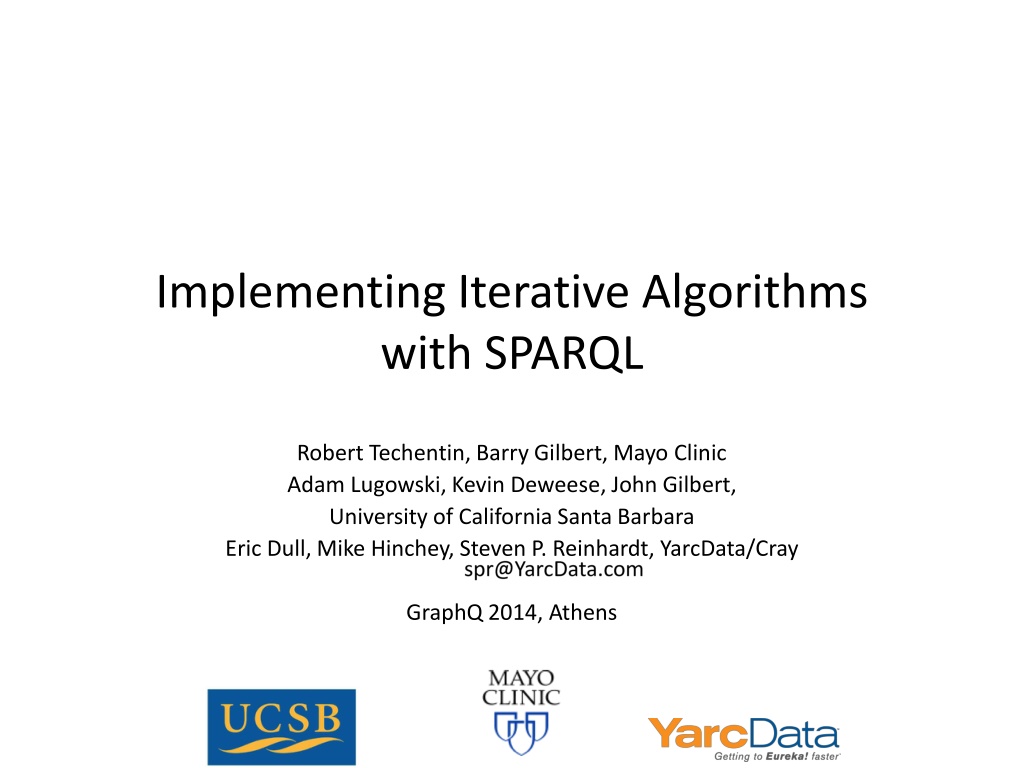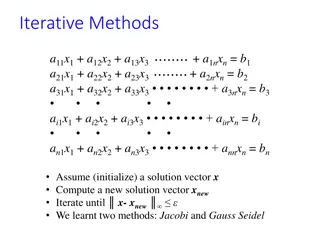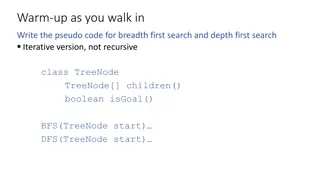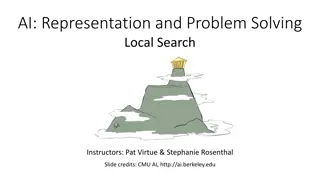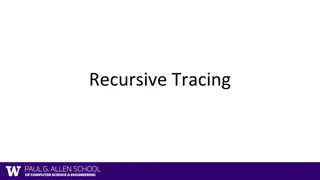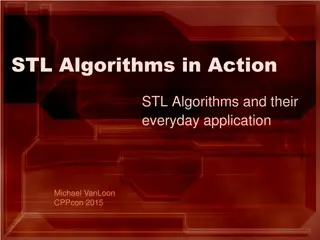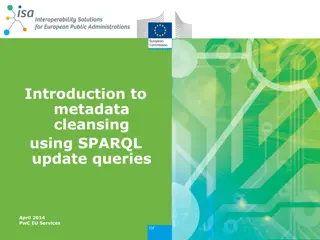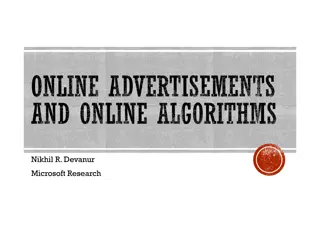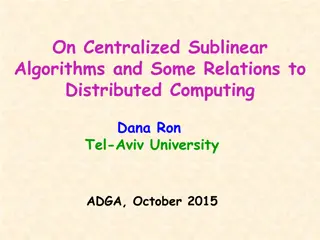Implementing Iterative Algorithms with SPARQL
This comprehensive guide explores the implementation of iterative algorithms with SPARQL, focusing on YarcData/Cray's approach to using these algorithms. It covers YarcData's interest in graphs, the Urika appliance, iterative algorithms in machine learning, implementation approach, and algorithms implemented such as peer-pressure clustering, graph diffusion, and label propagation.
Download Presentation

Please find below an Image/Link to download the presentation.
The content on the website is provided AS IS for your information and personal use only. It may not be sold, licensed, or shared on other websites without obtaining consent from the author. Download presentation by click this link. If you encounter any issues during the download, it is possible that the publisher has removed the file from their server.
E N D
Presentation Transcript
Implementing Iterative Algorithms with SPARQL Robert Techentin, Barry Gilbert, Mayo Clinic Adam Lugowski, Kevin Deweese, John Gilbert, University of California Santa Barbara Eric Dull, Mike Hinchey, Steven P. Reinhardt, YarcData/Cray GraphQ 2014, Athens
Agenda YarcData/Cray s interest in graphs and SPARQL Approach to using iterative algorithms with SPARQL Three implementations Lessons Future work
YarcData/Cray and Graphs YarcData develops and sells the Urika appliance An in-memory graph store scalable to 512TB of RAM Based on RDF/SPARQL standards Shipping since Jan2012 Typically working with 10-40B triples Target market is discovery analytics Subject-matter expert (human) is in the loop Discovery means a) need interactive response time (O(10s of seconds)) and b) queries are not known in advance graph
Iterative Algorithms Rich recent work in machine learning and related fields Want to reuse these algorithms on graphs, in RDF/SPARQL Many important algorithms are iterative (e.g., PageRank, Markov clustering, SVD) SPARQL has no mechanism for iteration And using nested queries appears insufficient
Implementation Approach Overhead of a SPARQL query is small enough to implement via multiple queries Resulting structure establish initial state do { update state measure convergence criteria } while (convergence not met) establish final state and clean up Intermediate state is typically large, so want it to reside in the DB, hence need to INSERT it
Algorithms Implemented Peer-pressure clustering (UCSB, YD) Clusters vertices by propagating the most popular cluster of each vertex s neighbors Graph diffusion (Mayo, YD) Models natural transport process, using the connectivity of the graph Can quantify which connections were most important to transportation Label propagation (YD) Similar to peer-pressure Clusters vertices by popularity, with self-voting possible
Peer-pressure Clustering Algorithm assign each vertex to an initial cluster of its own do { (re-)assign each vertex to the cluster to which a plurality of its neighbors belong count the number of vertices that changed cluster in the prior step } while (enough vertices changed or other criteria)
Vertex-(re)assignment Query INSERT { GRAPH <urn:ga/g/xjz[i+1]> { ?s <urn:ga/p/inCluster > ?clus3 } } WHERE { { SELECT ?s (SAMPLE(?clus) AS ?clus3) WHERE { { SELECT ?s (MAX(?clusCt) AS ?maxClusCt) WHERE { SELECT ?s ?clus (COUNT(?clus) AS ?clusCt) WHERE { ?s <urn:ga/p/hasLink > ?o . GRAPH <urn:ga/g/xjz[i]> {?o <urn:ga/p/inCluster > ?clus} } GROUP ?s ?clus } GROUP BY ?s } { SELECT ?s ?clus (COUNT(?clus) AS ?clusCt) WHERE { ?s <urn:ga/p/hasLink > ?o . GRAPH <urn:ga/g/xjz[i]> {?o <urn:ga/p/inCluster > ?clus} } GROUP BY ?s ?clus } FILTER (?clusCt = ?maxClusCt) } GROUP BY ?s } } For each vertex, find the cardinality of the most popular cluster to which its neighbors belong For each vertex, find the name and cardinality of each cluster to which its neighbors belong For each vertex, select the cluster which has cardinality equal to maximum cardinality
Lessons Pros This approach works Implementation is within the control of the developer, as it depends solely on standard SPARQL 1.1 and SPARQL Update functionality Performance can be very good Cons Implementation requires use of a second language for iteration (JavaScript and Python, in our cases); this complicates development, esp. debugging Computational inefficiencies Executing the same selection code (to focus on the vertices/edges in question) in each query is redundant INSERTing intermediate results is a heavier-weight operation than required
Lessons (2) Performance In RDF graph, data to be clustered is typically a small fraction of the total data Largest algorithm data 89M vertices / 1.6B edges Iteration times 40-1200s, depending on data size Number of iterations varies by algorithm and data Need algorithms that cope with heterogeneous data
A Related Development The ability to call a (possibly iterative) graph function built into the SPARQL endpoint PREFIX yd: http://yarcdata.com CONSTRUCT { # input graph for community detection algorithm consists of weighted edges ?vertex1 ?weight ?vertex2 . } WHERE { ?vertex1 <urn:hasLink> ?vertex2 . # following statement weights intra-clique edges 10X more than inter-clique BIND (IF(SUBSTR(STR(?vertex1),11,11)=SUBSTR(STR(?vertex2),11,11), "10"^^xsd:integer, "1"^^xsd:integer) as ?weight) } INVOKE yd:graphAlgorithm.community (maxCommunitySize=200) PRODUCING (?vertex ?communityID) New feature in Urika Spring 2014 release Likely better performance, though less control by query developer
Summary Implementing iterative algorithms through sequences of SPARQL queries is a reasonable approach Delivers good performance and great query- developer flexibility Inherent performance issues may inhibit extreme performance Likely to be one of a variety of means to implement graph algorithms in SPARQL
